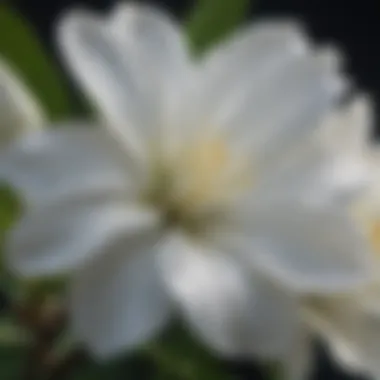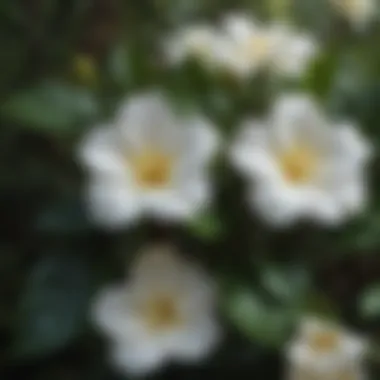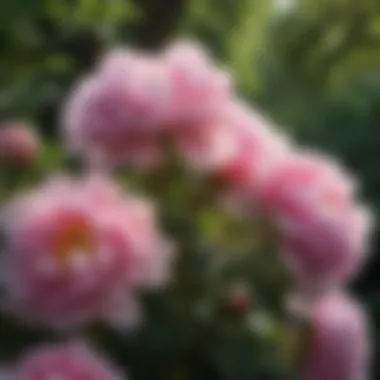Exploring the Allure of Strong Scented Flowers


Intro
The fascination with strong scented flowers goes beyond their aesthetic appeal. They play crucial roles in their ecosystems and cultures. This article provides a thorough examination of these floral wonders, emphasizing their characteristics and significance. Understanding their role in woodland ecosystems is the foundation for appreciating their broader impacts.
Understanding Woodland Ecosystems
Woodland ecosystems are rich environments that support diverse forms of life. Flowers with strong scents often attract pollinators, contributing to the reproductive success of plants. Here, we outline two key aspects of these ecosystems.
Importance of Biodiversity in Forests
Biodiversity is essential within forests for several reasons:
- Ecosystem Stability: High biodiversity boosts resilience against pests and diseases.
- Nutrient Cycling: Various species contribute to more efficient nutrient cycling.
- Habitat Availability: Diverse habitats support a range of wildlife.
In terms of strong scented flowers, they often indicate healthy ecosystems. Their presence can be a sign of favorable conditions for other species.
Role of Forests in Climate Regulation
Forests serve as significant carbon sinks. They absorb carbon dioxide, helping to mitigate climate change. Strong scented flowers can enhance this role by attracting various pollinators, which are crucial for maintaining plant diversity.
"Forests not only provide habitat for wildlife but also play a vital role in regulating the climate and improving air quality."
Sustainable Forestry Practices
Sustainable forestry practices ensure that we meet current needs without compromising future generations. The following principles are integral to this approach:
Principles of Sustainable Forestry
- Selective Logging: Minimizing damage to the ecosystem.
- Replanting Native Species: Supporting local wildlife and habitats.
- Monitoring Impact: Regular assessments to modify practices if necessary.
Case Studies of Successful Implementations
Looking at various regions, case studies provide valuable insights:
- Montana, USA: Implemented logging regulations successfully maintained biodiversity while allowing for economic gain.
- Scotland: Focused on native species reforestation, creating habitats for various wildlife.
Woodland Stewardship Techniques
Stewardship involves proactive management of woodland areas. It encompasses various techniques aimed at enhancing the health of the ecosystem.
Forest Management Plans
Effective forest management necessitates comprehensive planning:
- Assessment of Resources: Understanding existing flora and fauna.
- Setting Goals: Clear objectives for conservation and use.
- Engagement with Community: Local involvement in decision-making processes.
Conservation Strategies
Conservation efforts are crucial to protect these valuable ecosystems:
- Creation of Protected Areas: Designating specific regions for preservation.
- Invasive Species Management: Controlling non-native species to prevent them from overpowering indigenous flora.
The cultivation and conservation of strong scented flowers are intricately linked to the larger context of woodland ecosystems. Understanding these relationships facilitates effective management of resources and preservation of biodiversity. Collectively, these efforts contribute to a more sustainable and enriching environment that benefits both the flowers and the ecosystems they inhabit.
Prologue to Strong Scented Flowers
Strong scented flowers capture our attention with their captivating odors and visual appeal. These floral species play a significant role in both the natural environment and cultural practices. Understanding these flowers helps appreciate their ecological importance, which includes supporting local wildlife and contributing to the aesthetics of our surroundings.
Defining Scented Flora
Scented flora refers to flowers that produce strong and recognizable odors, which can range from sweet to spicy. These flowers come from various plant families and offer a variety of fragrances, each with its own unique properties. Common examples include roses, jasmines, and lavenders. These flowers are not just delightful for humans; they serve crucial functions in ecosystems. The scent produced helps in the attraction of pollinators like bees, butterflies, and other insects essential for plant reproduction.
Importance of Fragrance in Nature
The significance of fragrance in nature extends beyond mere aesthetics. Fragrances serve vital evolutionary functions. Notably, strong scents assist in the survival of plant species.


- Pollinator Attraction: Many plants have developed unique scents to attract specific pollinators, enhancing their chances of reproduction.
- Ecosystem Health: Strong scented flowers contribute to biodiversity. This biodiversity is crucial for maintaining healthy ecosystems, as it helps support a balanced food web.
"Fragrance is not just an indulgence; it is integral to the survival mechanisms of many plants, influencing their life cycles and interactions with pollinators."
The role of these scents aids in the symbiotic relationships between plants and animals, fostering an interconnected web of life that supports both floral and faunal diversity. This highlights the essential nature of strong scented flowers in ecological systems and encourages continued interest in their study and conservation.
Ecological Role of Strong Scented Flowers
The multifaceted nature of strong scented flowers plays a critical role in maintaining ecological balance. Their fragrance serves not only as an allure to wildlife but also as a unique attribute that contributes significantly to various ecological interactions. This section will explore how these flowers attract pollinators and support biodiversity, emphasizing their importance in woodland ecosystems.
Attracting Pollinators
Types of Pollinators
Strong scented flowers primarily attract a diverse range of pollinators. This includes bees, butterflies, and moths, which are essential for the process of pollination. Each kind of pollinator has different preferences and behaviors that enhance the effectiveness of flower pollination. For instance, bees are naturally drawn to flowers that have vibrant colors and strong fragrance. This makes them advantageous for the reproduction of flowering plants, ensuring that cross-pollination occurs efficiently.
Key characteristics of these pollinators include their reliance on floral scents and nectar. Bees, particularly honeybees, utilize their keen sense of smell to locate flowers. This unique feature ensures that they not only aid in pollination but also help enhance the genetic diversity of plant species. However, dependency on specific types of pollinators can present challenges, especially when pollinator populations decline.
"The presence of strong scented flowers in an ecosystem can significantly boost local pollinator populations, which is vital for the sustainability of plant communities."
Pollination Dynamics
Pollination dynamics refer to the processes and interactions that occur between flowers and their pollinators. Strong scented flowers create a complex network of relationships that vary depending on time of day, environmental conditions, and predator interactions. Many flowers, such as night-blooming jasmine, release their scent most strongly at night to attract moths.
The key characteristic of these dynamics is the timing and method of scent release in relation to the activity patterns of pollinators. Unique features of pollination dynamics could impact the reproductive success rates of plants. Still, this process can also be sensitive to changes in climate and habitat, affecting not only the plants but also the entire ecosystem.
Contributions to Biodiversity
Habitat Formation
Strong scented flowers contribute to the formation of habitats that support a wide variety of organisms. Different species of flowers create microhabitats that offer shelter and food sources for various insects, birds, and small mammals. This intricate relationship showcases how floral scents can influence the spatial distribution of plant species while benefiting other flora and fauna.
The main characteristic of habitat formation by scented flowers is their ability to create diverse plant communities. This diversity encourages stability within the ecosystem. However, changes in the environment, such as urbanization, can threaten these habitats and the biodiversity they support.
Nutrient Cycles
Nutrient cycles are essential for maintaining healthy ecosystems, and strong scented flowers participate actively in this process. When these flowers die back at the end of their lifecycle, they contribute organic matter to the soil. This, in turn, enriches the nutrient profiles of the ecosystem, supporting a range of other plants and animal life.
The key characteristic of nutrient cycles associated with scented flowers is their role in promoting soil health. By enhancing nutrient availability, these flowers contribute to a balanced ecosystem that fosters plant growth and supports diverse animal communities. Understanding this relationship highlights the importance of conserving fragrant flora, which plays a crucial role in nutrient cycling.
Prominent Varieties of Strong Scented Flowers
The world of strong scented flowers is not only diverse but also fascinating. Various varieties offer unique fragrances that are often associated with specific emotions and occasions. In this section, we will explore some of the most prominent varieties of strong scented flowers and their attributes.
Roses: A Timeless Classic
Varieties with Notable Fragrance
Roses are arguably one of the most well-known flowers around the globe. Among them, varieties such as the Damask rose and the Bourbon rose stand out due to their exceptional fragrances. The Damask rose is prized for its sweet scent, commonly used in perfumes. In contrast, the Bourbon rose is known for its rich, almost fruity fragrance. These varieties not only add beauty but also significantly enhance the sensory experience in gardens and landscaping. The choice of rose variety can transform a space into a fragrant haven, making them a popular choice for gardeners.
Cultural Implications
Roses have immense cultural value across various civilizations. They symbolize love, beauty, and passion. In various art forms and literature, roses often serve as potent symbols representing complex emotions. For instance, in the works of Shakespeare, roses frequently symbolize beauty and impermanence. The cultural implications of roses extend beyond aesthetics, embedding them in numerous traditions and historical narratives, which adds depth to their cultivation and appreciation.
Jasmine: The Night Bloom
Species Diversity
Jasmine species like Jasminum sambac and Jasminum grandiflorum are known for their striking fragrances that enchant those nearby. The sheer diversity in jasmine species allows for broad applications, from ornamental gardening to therapeutic uses. This variety contributes to the strong appeal of jasmine flowers, making them an essential choice for both enthusiasts and professionals in horticulture. Each species contributes uniquely to the aroma, enriching the overall olfactory experience.
Perfume Industry Significance
The jasmine flower plays a pivotal role in the perfume industry. Its essential oils are highly sought after, used to create some of the world's most luxurious scents. The floral notes of jasmine enhance the depth of perfumes, producing blends that are both fresh and intoxicating. Furthermore, jasmine's popularity in perfumery underscores its economic significance. This flower's cultivation is often seen as financially beneficial, especially in regions with favorable climates for growth.
Lavender: The Aromatic Staple


Therapeutic Uses
Lavender is renowned for its calming properties. The essential oils extracted from lavender are often utilized in aromatherapy, promoting relaxation and alleviating stress. Its therapeutic uses extend to skincare products, showcasing its versatility. Furthermore, lavender's widespread use in wellness practices highlights its significance in both traditional and modern health remedies. This flower also serves as a natural insect repellent, adding functionality alongside its aromatic benefits.
Culinary Applications
In culinary contexts, lavender can provide a unique flavor to both savory and sweet dishes. It complements various ingredients like honey and lemon, adding complexity to recipes. Lavender's culinary applications range from infused oils to baked goods, enhancing dishes with its distinct aroma. However, it is essential to use lavender sparingly, as its strong flavor can overpower a dish if misused.
Lilacs: A Spring Favorite
Genetic Variations
Lilacs are celebrated for their charming blooms and rich scents. Within this category, genetic variations such as the Syringa vulgaris provide diverse color forms and fragrance profiles. Their varying characteristics make lilacs adaptable to different garden themes, maintaining visual interest and scent throughout the growing season. This genetic variability amplifies their appeal among horticulturists aiming for unique plant compositions.
Regional Popularity
In many regions, lilacs are synonymous with spring. Their popularity in gardens speaks to their natural beauty and fragrance. In areas with colder climates, lilacs serve as a sign of warmer days ahead, reinforcing their emotional connections in people's memories and traditions. However, their dependency on climate conditions can limit their geographic range, impacting their widespread use.
Honeysuckle: A Fragrant Vine
Growth Habits
Honeysuckle, particularly varieties like Lonicera japonica, is valued for its vigorous growth habits. This climbing vine can adapt to various trellises and garden structures, providing lush greenery and fragrance. Its strong tendency to spread requires careful management, but with proper pruning, honeysuckle can enhance garden aesthetics dramatically. This adaptability makes it a favored choice for gardeners wishing to create vibrant vertical spaces.
Wildlife Benefits
Honeysuckle attracts a range of wildlife, including birds and pollinators. Its nectar-rich flowers provide crucial resources for these creatures, fostering biodiversity. As a result, cultivating honeysuckle can actively support local ecosystems, making it beneficial not only for gardens but also for the environment. The flowering periods of honeysuckle often align with the needs of pollinators, creating synergies that are essential in the study of ecological habitats.
Cultivation Techniques for Strong Scented Flowers
Cultivating strong scented flowers requires a deep understanding of their needs. Different varieties have unique requirements that can affect their growth and fragrance. By focusing on specific elements, benefits, and considerations related to cultivation techniques, one can achieve optimal results.
Soil and Climate Requirements
Soil and climate play crucial roles in the health of strong scented flowers. Most fragrant flowers prefer well-draining soil that is enriched with organic matter. This nutrient-rich environment supports healthy root systems and promotes flowering. For example, roses thrive in sandy loam that retains moisture yet provides ample drainage.
Climate is equally important. Many strongly scented flowers, like jasmine, need warm temperatures to flourish. Regions that experience mild winters and warm summers are suitable for their growth. Understanding local climate conditions can help in selecting appropriate species for cultivation.
Pest Management Strategies
Effective pest management is essential for maintaining the vitality of strong scented flowers. There are two popular approaches: natural deterrents and integrated pest management.
Natural Deterrents
Natural deterrents are eco-friendly options for controlling pests. They utilize plant-based substances or beneficial insects to ward off harmful species. For example, planting marigolds alongside scented flowers can repel nematodes and other pests. The key characteristic of natural deterrents is their non-toxic nature, making them beneficial for organic gardening practices. Additionally, they help maintain a balanced ecosystem in the garden.
However, natural deterrents can have variable effectiveness depending on the types of pests present. They might not eliminate infestations but rather keep them in check. Careful observation and monitoring are needed to ensure this approach meets the gardener's specific needs.
Integrated Pest Management
Integrated Pest Management (IPM) encompasses a holistic approach to pest control. This method combines cultural, biological, and chemical practices to reduce pest populations while minimizing harm to the environment. One of the primary characteristics of IPM is that it involves constant monitoring of pests and implementing control measures based on thresholds.
IPM is popular for its adaptability. It allows growers to select the most suitable methods of pest control based on current pest levels. Additionally, it promotes sustainable practices and reduces reliance on chemical pesticides. However, implementing IPM requires diligent management and knowledge of pest life cycles, which can be a barrier for some gardeners.
Watering and Fertilization Practices
Watering and fertilization are vital aspects of cultivating strong scented flowers. Proper watering techniques help ensure the plants receive the right moisture levels without becoming waterlogged. Most fragrant flowers prefer consistent watering. Overwatering can lead to root rot, which affects their ability to produce fragrance.
Fertilization should be conducted based on the specific needs of the flowers. Using slow-release fertilizers can provide nutrients over an extended period. It is essential to balance nitrogen, phosphorus, and potassium, as they contribute to healthy foliage, strong roots, and abundant blooms. Regular soil testing can help tailor fertilization to the flowers' changing needs throughout the growing season.
Cultural and Historical Significance
The realm of strong scented flowers transcends mere aesthetic appeal, embedding itself profoundly into cultural narratives and historical contexts. These flowers have been vehicles for communication, as their fragrances often evoke emotions, memories, and rituals throughout various cultures. Understanding their significance allows us to appreciate the multifaceted role they play in human society and the natural world.
Role in Art and Literature


Throughout history, strong scented flowers have served as powerful symbols in art and literature. Artists have often depicted these flowers to convey specific emotions or themes. For example, the rose frequently represents love and passion, while the lily can signify purity or renewal.
In literature, poets and writers use floral imagery to enrich their narratives. Flowers like jasmine often appear in romantic poetry, invoking the beauty associated with nightfall and intimacy. The lush scent of lavender can symbolize tranquility and healing, making it a common motif in wellness literature.
Here are some notable examples:
- Shakespeare frequently referenced scented flowers in his works. The imagery related to flowers enhances the emotional depth of his characters.
- Emily Dickinson wrote extensively about the beauty of nature. Her poems often reflect the scent and beauty of flowers, revealing their significance in shaping one’s experience of the world.
Strong scented flowers thus serve not only as physical entities but also as cultural icons, helping shape human experiences and expressions.
Scented Flowers in Traditional Rituals
Scented flowers play essential roles in various traditional rituals across cultures. They symbolize purity, beauty, and the connection between the physical and spiritual realms.
For example, in many cultures, jasmine is used in ceremonies to invoke a sense of serenity and peace. The delicate aroma of jasmine is often associated with both hope and celebration, marking important life events such as weddings and births.
Honeysuckle is another flower linked with traditional practices. In some cultures, it is used in offerings to deities, symbolizing devotion and gratitude. The sweet scent of honeysuckle evokes joy, emphasizing the connection between nature and spirituality.
In many Eastern cultures, floral garlands made from marigolds or lotus are integral to festivals and religious ceremonies. These flowers not only provide a rich fragrance but also signify prosperity and good fortune.
"Flowers are the music of the ground. From earth's lips, they speak the language of the soul, intertwining spirit with scent."
Preservation and Conservation Efforts
Preserving strong scented flowers is not just about maintaining their beauty and fragrance; it speaks to the vitality of our ecosystems. These flowers play a crucial role in attracting pollinators and supporting biodiversity. As climate change progresses and human activity alters habitats, many scented flower species face grave threats. Addressing these challenges requires a comprehensive conservation strategy that combines community involvement and legislative action.
Threats to Scented Flower Species
Strong scented flowers are threatened by several factors. Urbanization leads to habitat loss, which severely impacts their growth and survival. Additionally, climate change brings alterations in temperature and rainfall patterns, affecting their blooming cycles. Pests and invasive species also pose significant threats, as they can outcompete native flora, leading to biodiversity loss.
Key threats include:
- Habitat destruction due to urban expansion and agriculture.
- Climate change altering microclimates suitable for specific species.
- Invasive species overshadowing native fragrant flora.
- Pollution which causes deterioration of soil and air quality affecting plant health.
"The significance of preserving strong scented flowers extends beyond aesthetics; it touches on ecological integrity and human well-being."
Conservation Strategies
To effectively conserve strong scented flowers, a multi-faceted approach is necessary. Two essential strategies include community engagement and legislative support. Together, they create a framework that prioritizes sustainability and awareness around the importance of these floral species.
Community Engagement
Community engagement is vital for fostering local interest and participation in conservation efforts. This strategy encourages individuals to take action within their communities, creating a ripple effect. By involving local residents in preservation initiatives, conservationists can tap into unique knowledge and skills that enhance the success of efforts.
- Enhances local stewardship. Communities take ownership which leads to sustainable practices.
- Promotes education and awareness. Understanding the value of strong scented flowers encourages protection efforts.
- Builds local networks. Collaboration among community members can amplify outreach.
However, it can be challenging to keep people consistently engaged. Over time, interests may wane without continuous education and involvement.
Legislative Support
Legislative support plays a crucial role in establishing a protective framework for strong scented flower species. Through laws and policies, governments can designate protected areas and establish guidelines for sustainable practices. This approach leads to more formalized conservation actions that are essential for long-term success.
- Establishes protected areas. Secure habitats for the survival of rare species.
- Encourages funding for research. Legislative actions can drive financial support for conservation projects.
- Informs public policy. Effective legislation shapes societal actions towards sustainable practices.
Despite its advantages, navigating political landscapes can be arduous. Often, legislative action can be slow-moving and may not directly address immediate threats.
The preservation of strong scented flowers is ultimately a bidirectional process, where community engagement works in tandem with legislative support. This dual approach not only safeguards biodiversity but also enhances our understanding of the delicate balance within ecosystems.
Closure
The conclusion of this article encapsulates the multifaceted nature of strong scented flowers. These plants not only provide aesthetic beauty but play a vital role in ecosystems. Understanding their significance enhances appreciation for their natural elegance and ecological contributions. By highlighting key insights, it is crucial to recognize their impact on biodiversity, cultural practices, and their importance in cultivation and conservation strategies.
Summary of Key Insights
Strongs scented flowers serve various purposes, from attracting pollinators to being integral in cultural rituals. Some key takeaways from this article include:
- Ecological Importance: They support pollinator populations, contributing to plant reproduction and overall biodiversity.
- Cultural Significance: Different cultures have used their fragrances for centuries, finding roles in art, literature, and traditional practices.
- Practical Applications: Many strong scented flowers have therapeutic uses and culinary applications, underlining their value beyond cosmetics or ornamentation. This summary provides a comprehensive view of how these flora not only beautify spaces but also enrich human experience and support natural environments.
Encouragement for Continued Exploration
As we conclude, it is essential to encourage ongoing research and interest in strong scented flowers. Their nuances are vast and often underappreciated. By engaging in local horticultural societies, attending workshops, or exploring community gardens, individuals can deepen their understanding of these plants. Additionally, supporting conservation efforts ensures the survival of diverse species amidst environmental challenges. Explore online forums such as Reddit on gardening or visit resources like Wikipedia to discover more about specific varieties and their applications. Continuous exploration not only enriches knowledge but helps preserve the floral diversity that enriches our lives.







